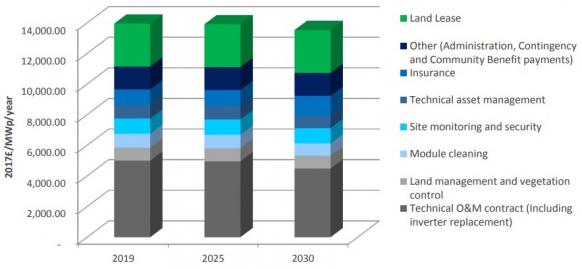Solar owners invest in land preservation to grow asset value
Solar plant investors are benchmarking biodiversity performance and investing in on-site measures to increase environmental value, industry experts told New Energy Update.

Related Articles
Growing environmental challenges are spurring the PV industry to improve the biodiversity of PV plants and achieve a "net positive" impact on the environment.
While solar power is helping to reduce carbon emissions, biodiversity is also under threat from agricultural intensification, pesticides, habitat loss and plastic pollution.
Well-designed and managed solar plants can support wildlife habitat and help nations achieve biodiversity targets, the UK Solar Trade Association (STA) said in a recent report, "The natural capital value of solar."
“By supporting healthy ecosystems at a local level…solar PV technology can play a significant role in the UK’s response to both the climate and biodiversity emergencies," the STA said.
Solar parks have the advantage of being secure sites which are left relatively unchanged and undisturbed for over 25 years. This allows time to nourish natural habitats and, at some sites, improve soil quality.
A "range of improvements” to improve biodiversity are possible, Chris Hewett, CEO of STA, told New Energy Update.
Keen to enhance their green credentials, solar investors are raising environmental targets for projects and driving new investments in land enhancements, Hewett said.
New metrics
Initiatives to add environmental value to solar farms include habitat preservation of flowers and native plants, beehive creation, hedgerow management to increase habitat diversity and measures that support sheep grazing.
Water management measures can also be implemented to improve biodiversity and provide more predictable access paths to equipment. Creating open drainage structures - such as ditches, swales, and balancing ponds - instead of sub-surface drainage, can create rich habitats for water-dependent invertebrates and amphibians.
UK-based solar investor Next Energy Capital (NEC) has worked with the Wychwood Biodiversity consultancy to deliver plans for biodiversity enhancements across 80 solar plants.
NEC is currently implementing a Biodiversity Management Plan (BMP) at nine sites and learnings from this phase will be used to establish a global approach.
In one example, NEC sowed wildflowers to attract pollinators at its 9 MW Berwick farm in East Sussex, England.
The operator also built “bug hotels” to encourage invertebrates to breed and is planning to create a nesting area and beehives for honey production.
Forecast PV capacity in Europe (cumulative)

Source: Wood Mackenzie, June 2019.
Investment group Bluefield has also implemented biodiversity enhancements at solar plants and benchmarked their performance.
Created in 2009, Bluefield has invested in over 1.6 billion pounds ($1.9 billion) of PV asset transactions and funds in the UK and Europe.
In its study, the company compared data from ecological assessments, tree and habitat surveys, biodiversity management plans and landscaping, against biodiversity performance. Key focus areas included wildflower meadow creation, native hedgerow planting and habitat creation to support local wildlife, including bat boxes, bird boxes and beehives.
Bluefield is also developing more advanced measures such as bug hotels and new ponds, and seeking synergies with the agricultural sector, such as the provision of pollinator habitat and allowing sheep to graze during the winter months.
Many UK developers make large-scale solar sites available to local farmers for conservation-focused grazing.
When developing a new solar park, Bluefield considers the possibility of on-site sheep grazing at an early stage, STA said in its report.
This includes a contractual requirement to protect cables and other equipment from sheep damage, and considering sheep grazing when designing clearance between the ground and the front row of PV panels and other equipment, it said.
Early adopters
Solar developers must implement biodiversity measures at the design stage to maximize the benefits, Hewett said.
There is no “one size fits all” approach as measures will depend on land characteristics and location, he said.
Crucially, the project must preserve the species found on site before the project, Guy Parker, founder and co-director of Wychwood Biodiversity, told New Energy Update. Developers can then implement measures that increase the biodiversity through the life of the project.
Land enhancement to increase biodiversity is a relatively new approach for solar PV owners and operations and maintenance (O&M) businesses will need to adapt as new measures become commonplace.
Forecast UK solar opex by category
(Click image to enlarge)
Source: Solar Trade Association, December 2018.
Simple steps include allowing hedgerows to grow taller or allowing grass areas to grow longer, Parker said.
“In both cases, this involves reducing the frequency of cutting, and should be more cost efficient in the long term,” he said.
Sites with sufficient land or restricted use can go further and introduce grassland, ponds or wildflowers.
In particular, sites with void areas, such as beneath power lines or over archaeological sites, provide space to implement and manage new habitats. This could include establishing different types of grassland, ponds, or wildflowers.
Wildflower meadows can be very valuable for wildlife, and the cost of these can range between 1,000 and 10,000 pounds per site, depending on the area, Parker said.
Cutting CO2
Solar operators can also look to reduce the amount of carbon dioxide in the local atmosphere.
Land management for solar farms is typically less intensive than for arable land, requiring less vehicle use, and the creation of a permanent grassland beneath solar panels creates a root mat that captures atmospheric carbon in the ground, Parker said.
Solar parks built on low-grade agricultural fields could help improve general soil quality, Alona Armstrong, Researcher and Senior Lecturer in Energy & Environmental Sciences at Lancaster University, told New Energy Update.
However, solar groups could face difficult decisions between cutting CO2 emissions and limiting land degradation. Research shows solar facilities can impact the microclimate by changing the temperature and moisture levels of soil under the panels, Armstrong said.
This can affect environmental processes such as vegetation growth and alter the amount of carbon stored in the soil.
Careful site design can “enhance positive effects and minimize negative effects," Armstrong noted.
Mitigation measures could include changing the spacing of the panels or using bifacial panels that allow more light through, she said.
To help solar owners make decisions on biodiversity enhancements, researchers at Lancaster University and the University of York have developed the Solar Park Impact on Ecosystem Services (SPIES) online tool.
Co-developed with the solar industry and based on over 700 evidence cases, the tool provides a scientific evidence base to achieve a potential ‘net environmental gain’ for solar projects.
By Beatrice Bedeschi

